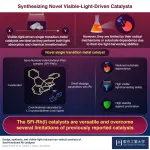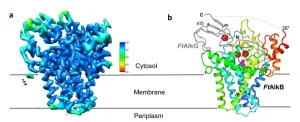(Press-News.org)
Worcester, Mass. – March 30, 2023 – A new study led by Worcester Polytechnic Institute (WPI) brings into sharper focus the structural details of the COVID-19 virus, revealing an elliptical shape that “breathes,” or changes shape, as it moves in the body. The discovery, which could lead to new antiviral therapies for the disease and quicker development of vaccines, is featured in the April edition of the peer-reviewed Cell Press structural biology journal Structure.
“This is critical knowledge we need to fight future pandemics,” said Dmitry Korkin, Harold L. Jurist ’61 and Heather E. Jurist Dean’s Professor of Computer Science and lead researcher on the project. “Understanding the SARS-COV-2 virus envelope should allow us to model the actual process of the virus attaching to the cell and apply this knowledge to our understanding of the therapies at the molecular level. For instance, how can the viral activity be inhibited by antiviral drugs? How much antiviral blocking is needed to prevent virus-to-host interaction? We don’t know. But this is the best thing we can do right now—to be able to simulate actual processes.”
Feeding genetic sequencing information and massive amounts of real-world data about the pandemic virus into a supercomputer in Texas, Korkin and his team, working in partnership with a group led by Siewert-Jan Marrink at the University of Groningen, Netherlands, produced a computational model of the virus’s envelope, or outer shell, in “near atomistic detail” that had until now been beyond the reach of even the most powerful microscopes and imaging techniques.
Essentially, the computer used structural bioinformatics and computational biophysics to create its own picture of what the SARS-COV-2 particle looks like. And that picture showed that the virus is more elliptical than spherical and can change its shape. Korkin said the work also led to a better understanding of the M proteins in particular: underappreciated and overlooked components of the virus’s envelope.
The M proteins form entities called dimers with a copy of each other, and play a role in the particle’s shape-shifting by keeping the structure flexible overall while providing a triangular mesh-like structure on the interior that makes it remarkably resilient, Korkin said. In contrast, on the exterior, the proteins assemble into mysterious filament-like structures that have puzzled scientists who have seen Korkin’s results, and will require further study.
Korkin said the structural model developed by the researchers expands what was already known about the envelope architecture of the SARS-COV-2 virus and previous SARS- and MERS-related outbreaks. The computational protocol used to create the model could also be applied to more rapidly model future coronaviruses, he said. A clearer picture of the virus’ structure could reveal crucial vulnerabilities.
“The envelope properties of SARS-COV-2 are likely to be similar to other coronaviruses,” he said. “Eventually, knowledge about the properties of coronavirus membrane proteins could lead to new therapies and vaccines for future viruses.”
The new findings published in Structure were three years in the making and built upon Korkin’s work in the early days of the pandemic to provide the first 3D roadmap of the virus, based on genetic sequence information from the first isolated strain in China.
About Worcester Polytechnic Institute
WPI, a global leader in project-based learning, is a distinctive, top-tier technological university founded in 1865 on the principle that students learn most effectively by applying the theory learned in the classroom to the practice of solving real-world problems. Recognized by the National Academy of Engineering with the 2016 Bernard M. Gordon Prize for Innovation in Engineering and Technology Education, WPI’s pioneering project-based curriculum engages undergraduates in solving important scientific, technological, and societal problems throughout their education and at more than 50 project centers around the world. WPI offers more than 70 bachelor’s, master’s, and doctoral degree programs across 18 academic departments in science, engineering, technology, business, the social sciences, and the humanities and arts. Its faculty and students pursue groundbreaking research to meet ongoing challenges in health and biotechnology; robotics and the internet of things; advanced materials and manufacturing; cyber, data, and security systems; learning science; and more. www.wpi.edu
END
CLEVELAND – A study published in the March 30 issue of the New England Journal of Medicine has shown that there may finally be an alternative to amputation for patients suffering from chronic limb-threatening ischemia (CLTI), the most severe form of peripheral artery disease. This study, co-led by University Hospitals (UH) Harrington Heart & Vascular Institute, could lead to the first FDA approval of a therapy giving thousands of patients hope for an alternative to limb loss.
THERAPY SAVES MOST PATIENTS FROM AMPUTATION
The PROMISE II U.S. pivotal clinical trial found that minimally ...
NEW YORK, NY (March 30, 2023)--With a transformational gift from the Bezos Family Foundation, Columbia will launch the Center for the Transition to Parenthood (TtP) in the Department of Obstetrics and Gynecology (Ob/Gyn). Supported by the most advanced scientific knowledge in the field, the TtP Center seeks to reinvent prenatal care, address the mental health of parents, improve the overall health of their infants, and promote family well-being.
The Center, established with a gift of $21 million from the Bezos Family Foundation, will develop, test, and put into practice a range ...
Shigella bacteria can infect humans but not mice. In the March 29 issue of Nature, a team from UConn Health explains why. Their findings may explain the multifariousness of a key weapon of our immune system.
Shigella infections cause fever, stomach pain, and prolonged, sometimes bloody diarrhea for as long as a week. The bacteria sicken 450,000 people each year in the US alone. Although most people recover on their own, children and those with weakened immune systems are at risk of Shigella ...
An international team of researchers, led by Drexel University, has found that a thin coating of MXene — a type of two-dimensional nanomaterial discovered and studied at Drexel for more than a decade — could enhance a material’s ability to trap or shed heat. The discovery, which is tied to MXene’s ability to regulate the passage of ambient infrared radiation, could lead to advances in thermal clothing, heating elements and new materials for radiative heating and cooling.
The group, including materials science ...
Photocatalysis is the use of light to accelerate the rate of a reaction in the presence of a photocatalyst. The catalyst plays a crucial role in this process—it absorbs the light being shined onto it and makes it available in way that can help accelerate the chemical reaction and also enhance it. These catalysts are used for a variety of light-dependent reactions ranging from the production of paper to the conversion of carbon dioxide to fuel. Given these applications, the development of ideal photocatalysts is important. An ideal ...
UPTON, NY—Scientists at the U.S. Department of Energy’s Brookhaven National Laboratory have produced the first atomic-level structure of an enzyme that selectively cuts carbon-hydrogen bonds—the first and most challenging step in turning simple hydrocarbons into more useful chemicals. As described in a paper just published in Nature Structural & Molecular Biology, the detailed atomic level “blueprint” suggests ways to engineer the enzyme to produce desired products.
“We want to create a ...
Why do cancer immunotherapies work so extraordinarily well in a minority of patients, but fail in so many others? By analysing the role of neutrophils, immune cells whose presence usually signals treatment failure, scientists from the University of Geneva (UNIGE), from Harvard Medical School, and from Ludwig Cancer Center have discovered that there is not just one type of neutrophils, but several. Depending on certain markers on their surface, these cells can either promote the growth of tumours, or fight them and ensure the success of a treatment. By boosting the appropriate factors, neutrophils could become great agents of anti-tumour ...
Summary
Scientists have come up with a new method to study the mechanical properties of developing embryos with unprecedented speed
The new method – line-scanning Brillouin microscopy (LSBM) – relies on a microscopy technique based on Brillouin scattering – a phenomenon where light interacts with naturally occurring thermal vibrations within materials.
The method, which can be used to non-invasively study developing embryos in three dimensions and across time, was selected as one of The Guardian's ...
Buprenorphine initiation in the ER found safe and effective for individuals with opioid use disorder who use fentanyl
With historically high overdose death rates in U.S., multi-site NIH study reinforces importance of continued, uninterrupted access to addiction medication
Results from a multi-site clinical trial supported by the National Institutes of Health showed that less than 1% of people with opioid use disorder whose drug use includes fentanyl experienced withdrawal when starting buprenorphine in the ...
A new UC San Francisco-led study brings scientists closer to understanding the causes of a mysterious rash of cases of acute severe hepatitis that began appearing in otherwise healthy children after COVID-19 lockdowns eased in the United States and 34 other countries in the spring of 2022.
Pediatric hepatitis is rare, and doctors were alarmed when they started seeing outbreaks of severe unexplained hepatitis. There have been about 1,000 cases to date; 50 of these children needed liver transplants and at least 22 have died.
In the study, publishing on March 30 in Nature, researchers linked the disease to co-infections from multiple common viruses, in particular a strain of ...







